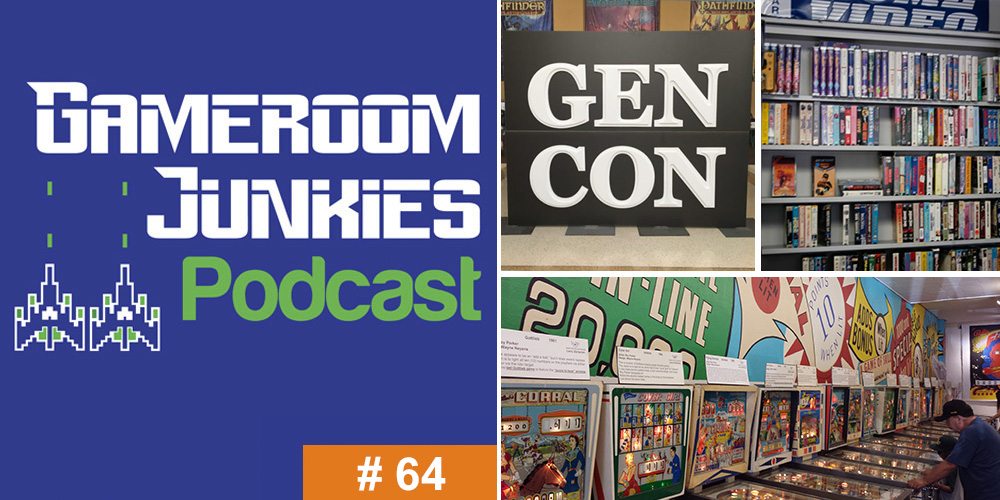![]() If you’ve ever dreamed of designing a theme park for robots … you’re kind of strange. But apparently not alone: Steam Park is a board game from Cranio Creations and Iello Games that lets you do just that. Released late last year, it combines all sorts of interesting mechanics like simultaneous die-rolling and drawing meeples out of a bag, and it’s very entertaining.
If you’ve ever dreamed of designing a theme park for robots … you’re kind of strange. But apparently not alone: Steam Park is a board game from Cranio Creations and Iello Games that lets you do just that. Released late last year, it combines all sorts of interesting mechanics like simultaneous die-rolling and drawing meeples out of a bag, and it’s very entertaining.
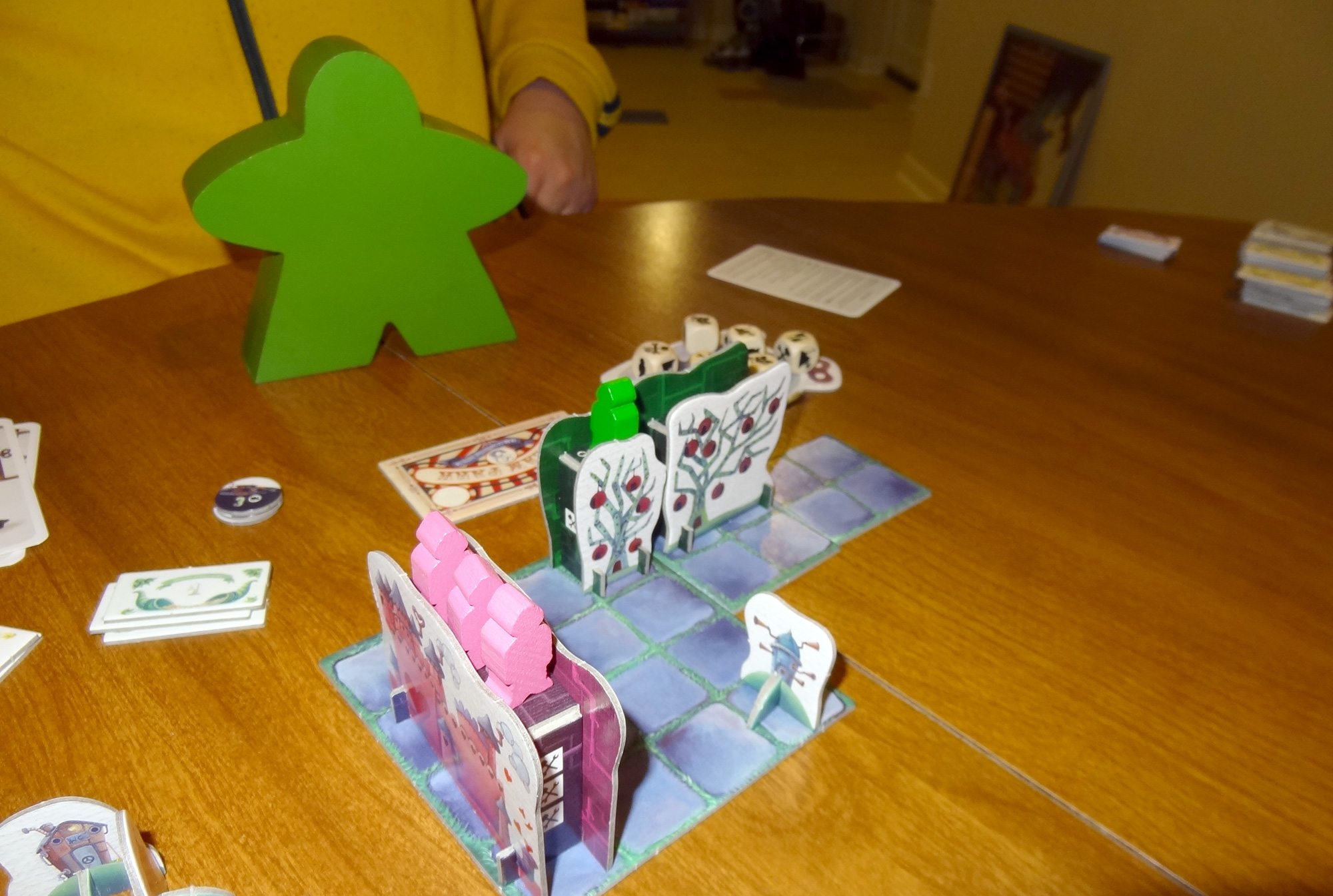
At a Glance
Steam Park is for 2 to 4 players, ages 10 and up, takes about an hour to play (less with fewer players), and retails for $39.99.
The story is that you’re all competing to set up amusement parks outside Roboburg. Robots love going on rides, but each one has a preferred type. The robots are also very concerned about the environment, though, so you need to clean up the dirt generated by building things, or face severe fines. The winner is the player who earns the most income by the end of the game.
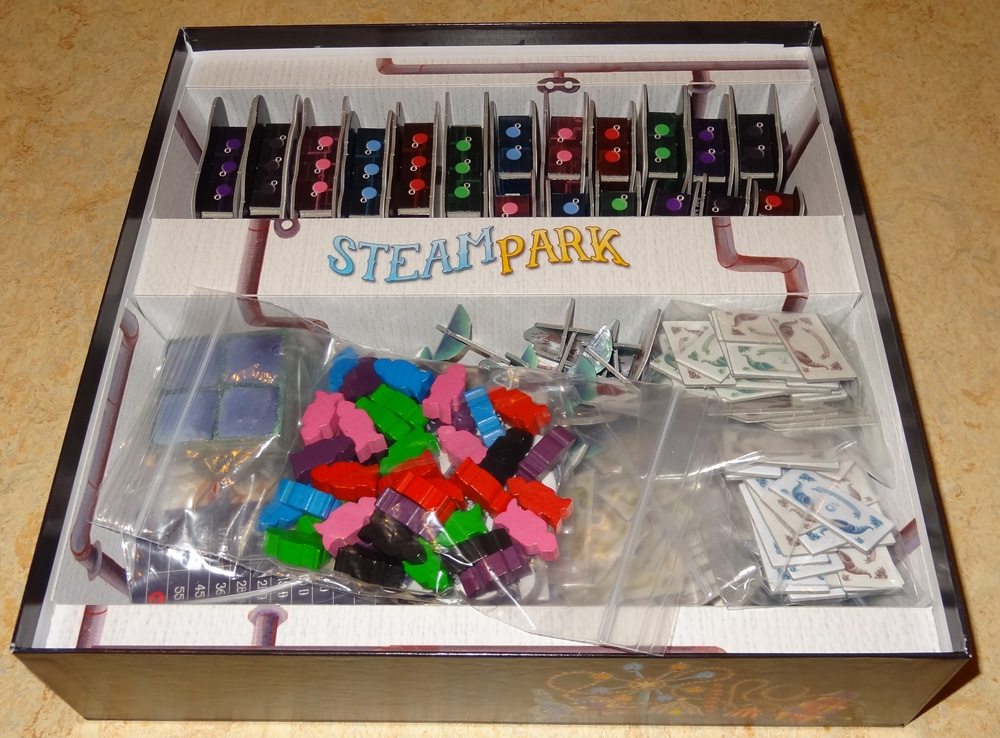
Components
Steam Park comes with the following:
- 24 wooden dice
- 18 rides (6 each Large, Medium, and Small)
- 42 visitor meeples (7 each in 6 colors)
- 4 pig boards
- 4 turn order tokens
- 4 starting ground tiles
- 20 additional ground tiles
- 1 turn counter
- 1 turn track
- 1 final dirt track
- 84 currency tokens (1, 5, 10, and 50 Danari denominations)
- 48 dirt tokens
- 1 cloth bag
As you can see, that’s a lot of stuff. The rides are each made of three pieces of cardboard, and took a little time to assemble before the first game. You do have to be careful with that, because one of mine tore slightly as I was folding and notching it together. One nice feature is that the box divider is designed so that after you punch everything out and assemble the rides and stands, there’s room for everything with not too much wasted space.
The dice are natural-colored wooden dice, with five different icons representing the various actions you can take. The rides are all color coded, with three sizes that can hold one, two, or three riders. The stands are a simple cardboard token with a notched base. The riders are little wooden robot meeples, and you use the cloth bag to randomize your draws—the bag is a nice black velvety material and works well.

Overall, the game looks great, particularly once you’ve started building up your theme parks with rides and riders and stands. However, sometimes it felt a little impractical, particularly because the game involves speedy dice-rolling and grabbing for a turn order token. More than once I’ve seen players trash their theme parks while grabbing for the tokens, because skinny meeples balanced on top of the rides can be a bit precarious.

Also, the five different stands aren’t labeled in any way. There are reference cards that indicate what they are, and probably after repeated plays you’ll learn the differences, but it might have been nice just to have little icons on them to remind you what they do. The Security and Casino stands are both striped tents, and they’re small enough that you can’t make out all the details without looking really closely.
Between the rides and the stands, the game would have been functionally the same with just flat tokens that you laid out on the grounds tiles, but it wouldn’t have looked nearly as nice once you had your park built. You’d probably be in less danger of knocking things over, though.

The numbers for the danari (the currency in the game) and on the turn order tokens are done in a carnival-esque font, which may be thematically appropriate but makes them hard to read at a glance. I think the design could have been a little less busy to make them more easily legible.
The rulebook is actually quite funny—it’s divided into the important rules and the “boring” rules that you can skip if you just want to get straight to the game. For instance, in the section about rolling dice, the “Boring and Obvious Rules” state:
When you move a die from the table to the Pig board you can’t change its face; if it flips by accident or you inadvertently change one of the dice already on the Pig board, you can’t turn it back to its original face. … If you “inadvertently” change the result “by accident” on purpose, please know that you are a bad person, and we pity you, you despicable game-spirit-ruining cheater.
There’s a little more of this type of humor scattered throughout the rulebook, and it makes it more entertaining if you’re reading through it to learn the game. The full rulebook is available as a PDF here.
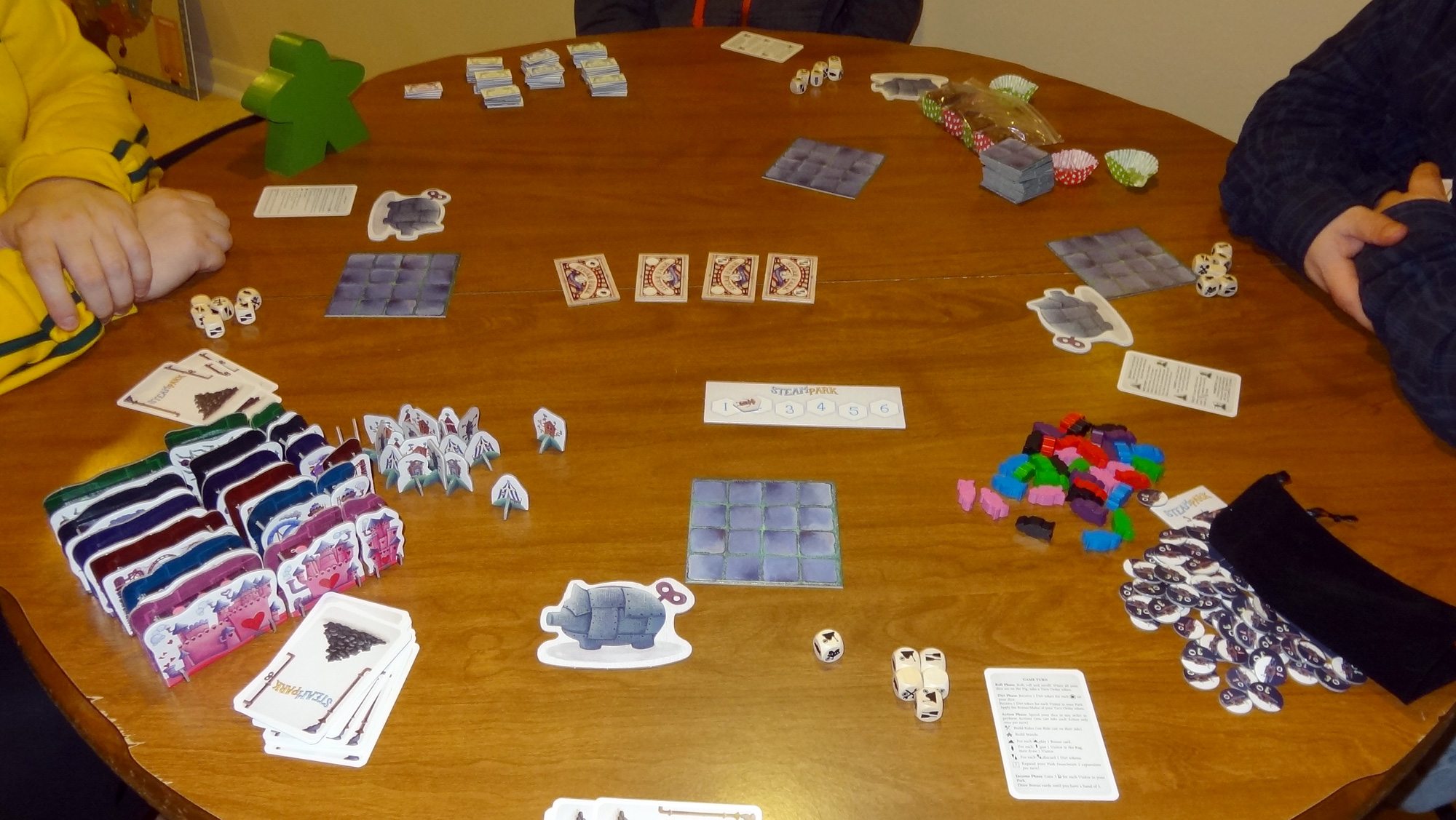
How to Play
The object of the game is to earn the most income over six rounds, which you do by attracting visitors to your park and playing bonus cards. You’ll also have to pay a fine for the amount of dirt you have left at the end of the game.
Each player starts with a small 4×4 plot of land, a Pig board, 6 dice, and a hand of 3 bonus cards. You start with one of each color meeple in the black bag, and all of the supplies placed to the sides of the table. In the center of the table, you place the turn order tokens (as many as there are players).
Each round has four phases: Roll, Dirt, Actions, and Income.

During the Roll phase, somebody gives a signal and then everyone starts rolling their own set of dice, trying to get the symbols they want. Dice you want to keep go on your Pig board and can’t be changed, but you can keep re-rolling the rest. Once all your dice are on your pig, you then grab one of the turn order tokens—the faster you finish, the more dirt you can clean up. (Last place gets extra dirt.)
The Dirt phase is where you get dirt tokens: any die that has a little round circle icon generates a dirt.
The Actions phase is the main portion of the game. In turn order, you do the following with your dice:
- Build rides: spend 1 to 3 build dice to build rides of that size
- Build stands: each stand die builds 1 stand
- Bonus card: play a bonus card from your hand, and collect income
- Clean up: each clean up face discards two dirt
- Attract visitors: each die lets you attract one visitor
- Expand park: any non-blank die face can be used to add a 2×2 piece to your park
- (Blank faces do nothing)
When building rides and stands, things of the same type or color have to be adjacent to each other, and completely separate from things of different types. Although it doesn’t spell it out in the rulebook, I like to think of this as leaving walkways through your park between things.
The attract visitors action is interesting. The game starts with one of each color meeple in the bag. For each visitor you attract, you’ll put one meeple of your choice into the bag, and then draw one out. (So if you have three visitors, you pick three, throw them in, and then draw three back out.) Visitors that match empty spaces on your rides come to your park; those that don’t get discarded. That means you’re rarely guaranteed to get the visitors you need, but the more you can put in (and the more different color rides you have), the better your odds.
The various stands give you different abilities, from changing die faces to counting certain dice twice to letting you keep visitors of the wrong color, and each stand you have lets you use its ability once per round.

At the end of each round is the Income phase, in which you collect 3 danari for each visitor in your park, and replenish your hand back to 3 bonus cards if you played any this round.
The game ends after six rounds (which always feels too soon!). After the last income phase, then everyone has to pay up for any dirt tokens they have left—the more you have, the stiffer the fine. (If you have 30 or more dirt, you just flat-out lose.)
The Verdict
Steam Park is pretty fascinating. Although most of the separate mechanics aren’t totally new, the combination is fresh and the seemingly disparate elements make a very entertaining whole—kind of like a theme park, I suppose. When I first read over the rules, I wondered how it would feel to combine the frantic die-rolling with laying out structures on a board and drawing meeples out of a bag. Having played it, though, I really love it because there are several different types of decisions you get to make throughout the game.
During the Roll phase, you have to decide both what dice you want to keep and how long you want to keep rolling so you don’t end up with too much dirt. Go really fast and you’ll get those extra brooms to prevent dirt, but you may not wind up being able to build out a good park. Too slow, and you’ll have a really fun but really dirty park.
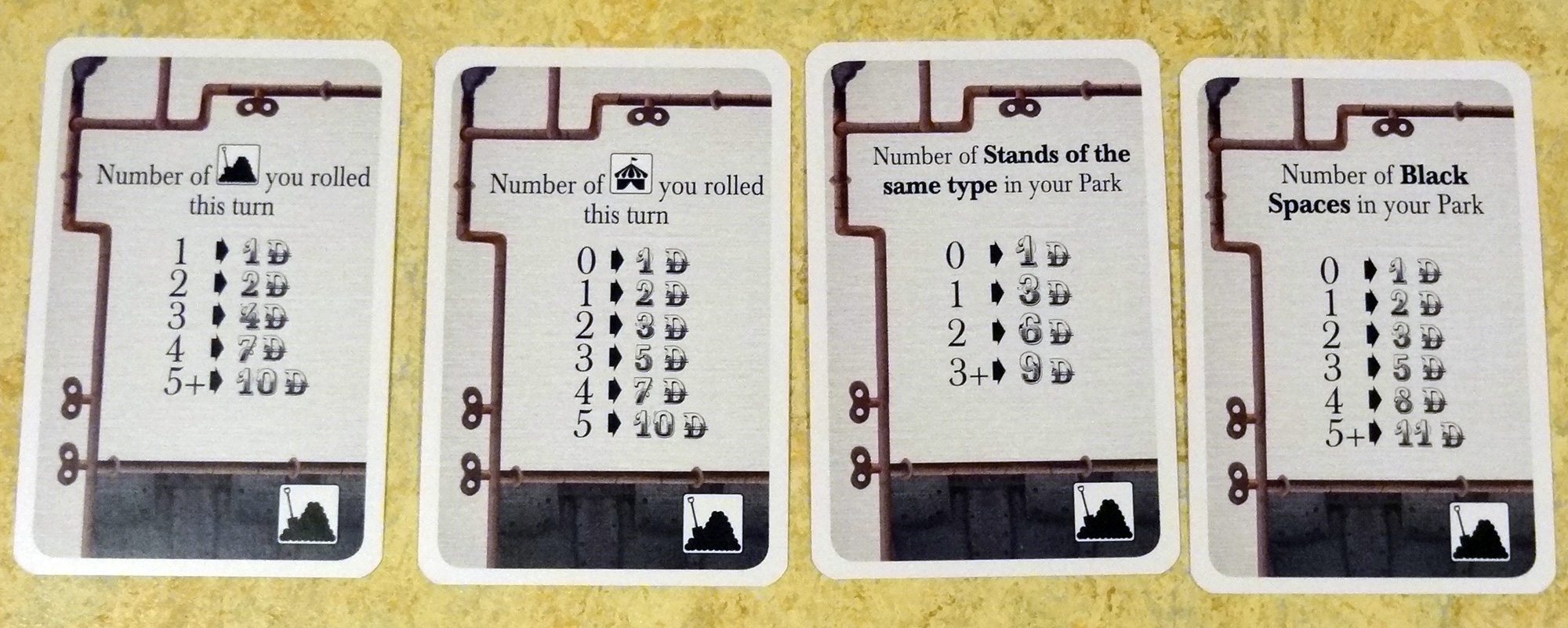
The bonus cards are really what direct you toward one strategy or another. While they may seem optional because they’re “bonus” cards, they’re crucial to consider before you start rolling dice. You may have bonuses for a particular color of ride or visitors, or you might want to have a lot of stands. Some even award you for the number of some particular die face you rolled this turn. Every time you get replacement cards, you draw two and keep one, which lets you adjust your strategy a little bit. Being able to play several cards throughout the game can earn you as much as the visitors to your park.
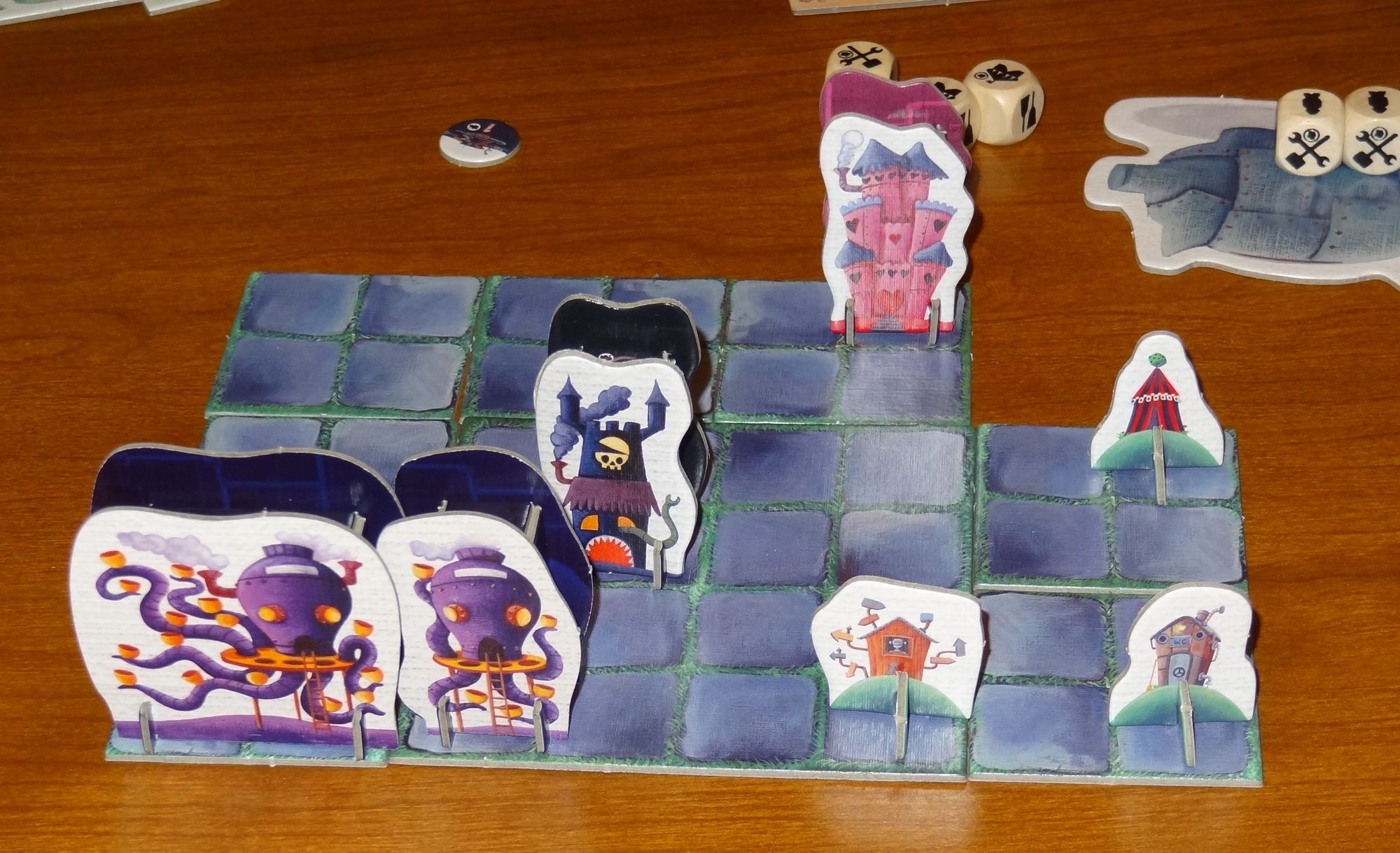
The placement of all of your rides and stands is also important, since you can’t move things around once you’ve placed them. If you want a bunch of different types of stands and different colored rides, then you’ll need to buy land expansions so there’s room for all the space in between things. I misjudged the placement of an early ride, and ended up with wasted space I couldn’t use. The land planning aspect is another mechanic that adds some fun strategic choices.
Despite all of the different phases of each round, the game still feels pretty quick. By round six you’ll find yourself saying, “Already? But I had all these plans!” It’s always a good feeling when you want to play a game again right after finishing.
Steam Park is a blast to play. The pieces are a bit fiddly and the stands really could have been better marked, but the whole thing presents several types of physical and mental challenges that I found pretty satisfying. If you like rolling dice and planning out your own little corner of the world, get your ticket for Steam Park.
Disclosure: Iello Games provided a review copy of this game through Tomoson.com.




